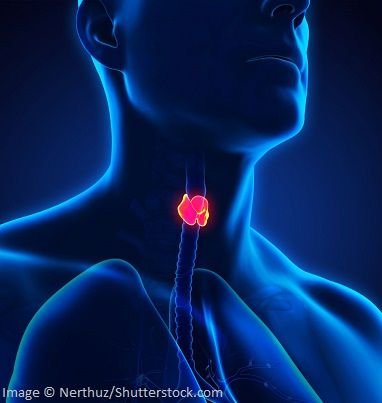Thyroidectomy Shows Noninferiority Without Radioiodine in Thyroid Cancer
A greater proportion of excellent responses were reported without radioiodine than with radioiodine when treating patients with low-risk thyroid cancer.
A greater proportion of excellent responses were reported without radioiodine than with radioiodine when treating patients with low-risk thyroid cancer.

Thyroidectomy with a follow-up strategy excluding radioiodine (131I) administration displayed noninferiority in patients with low-risk differentiated thyroid cancer vs the use of radioiodine administration, according to a prespecified 5-year analysis of the phase 3 ESTIMABL2 trial (NCT01837745) published in The Lancet Diabetes and Endocrinology.1
Data from the trial revealed that among patients who were treated for thyroid cancer with (n = 344) or without radioiodine (n = 354), the event-free survival (EFS) rate at 5 years was 94.8% (95% CI, 91.9%-96.7%) vs 93.2% (95% CI, 90.1%-95.4%), respectively. Additionally, the unadjusted difference between groups was –1.6% (90% CI, –4.5% to 1.4%), which did not exceed the non-inferiority margin of –5%. Similar results were elicited when assessing 5-year EFS in the intent to treat population; 95.4% (95% CI, 92.8%-97.1%) vs 93.6% (95% CI, 90.7%-95.8%); difference of –1.7% (90% CI, –4.4% to 1.0%).
Additionally, through local thyroglobulin determination use, the rate of an excellent response, according to the 2015 American Thyroid Association treatment response definition, was higher in patients in the no radioiodine group (83.3%) vs the radioiodine group (75.6%). Additionally, a greater proportion of patients who underwent radioiodine treatment had an indeterminate response vs those who did not (19.8% vs 7.3%). Furthermore, no significant difference in the proportion of patients with structural disease was observed, accounting for 0.9% of the no radioiodine group and 0% of the radioiodine group.
“After 5 years of follow-up, we found that a follow-up strategy without a postoperative radioiodine administration is not inferior to a postoperative administration of 1.1 GBq [of] 131I after recombinant human thyrotropin-stimulating hormone, with an event rate including functional, structural, and biological events of 6.0%,” Sophie Leboulleux, MD, PhD, endocrinologist in the Department of Nuclear Medicine of Institut Gustave Roussy in Villejuif, France, and member of the International Thyroid Oncology Group, wrote in the publication with study coinvestigators.1 “There is no loss of opportunity in following these patients without postoperative ablation.”
Patients with low-risk differentiated thyroid cancer treated with total thyroidectomy with or without prophylactic neck lymph node dissection (n = 776) were randomly assigned 1:1 to receive either postoperative radioiodine (n = 389) or a follow-up strategy without iodine (n = 387) from May 2013 to March 2017.
Patients in the radioiodine group received 1.1 GBq of radioiodine under thyroid hormone treatment 24 hours following a second 0.9 mg intramuscular injection of recombinant human thyrotropin on 2 consecutive days. Whole-body scanning and single-photon emission neck CT was performed between 2 and 5 days following radioiodine treatment. Initial follow-up included thyroglobulin measurement under recombinant human-thyrotropin-stimulating hormone stimulation with thyroglobulin antibody measurement and neck ultrasonography 10 months following random assignment. Subsequent follow-up consisted of thyroglobulin measurement under thyroid hormone treatment and of thyroglobulin antibody every year, and a neck ultrasonography every 2 years.
Follow-up for patients not assigned to radioiodine was aligned with the subsequent follow-up protocol in the radioiodine group.
Among groups assigned to radioiodine or no radioiodine, the median age was 52.2 years (IQR, 42.3-62.7) vs 52.9 years (IQR, 42.7-63.9), 82.0% vs 83.5% were female, and a total of 92.1 (SD, 23.2) vs 91.2 (SD, 23.6) days passed from thyroidectomy to random assignment, respectively. In respective groups, 95.6% vs 96.1% had papillary histology, the median tumor size was 13 (IQR, 11-15) vs 14 mm (IQR, 11-17), and 42.2% vs 45.0% had a pTNM stage of pT1bNX. Additionally, 45.8% vs 44.2% had multifocality, 44.0% and 44.2% had a neck dissection performed, and the median thyroglobulin levels at random assignment were 0.26 (IQR, 0.10-0.59) and 0.20 ng/mL (0.10-0.40), respectively.
The study’s primary efficacy end point was 3-year EFS.2 Secondary end points included 5-year EFS, patient quality of life (QOL), anxiety, and fear of recurrence, recurrence rate, rate of events adjusted on initial lymph node status or tumoral molecular characterization, and toxicity.
References
- Leboulleux S, Bournaud C, Chougnet CN, et al. Thyroidectomy without radioiodine in patients with low-risk thyroid cancer: 5 years of follow-up of the prospective randomised ESTIMABL2 trial. Lancet Diabetes Endocrinol. 2025;13(1):38-46. doi:10.1016/S2213-8587(24)00276-6
- Differentiated thyroid cancer: is there a need for radioiodine ablation in low risk patients? (ESTIMABL2). ClinicalTrials.gov. Updated May 17, 2023. Accessed January 30, 2025. https://tinyurl.com/3pk792ep
Newsletter
Stay up to date on recent advances in the multidisciplinary approach to cancer.